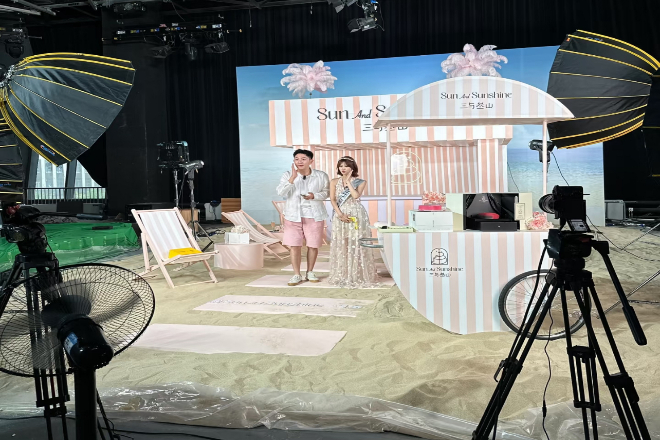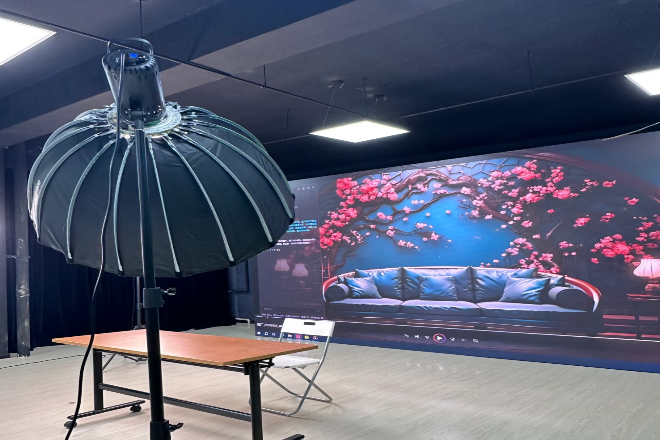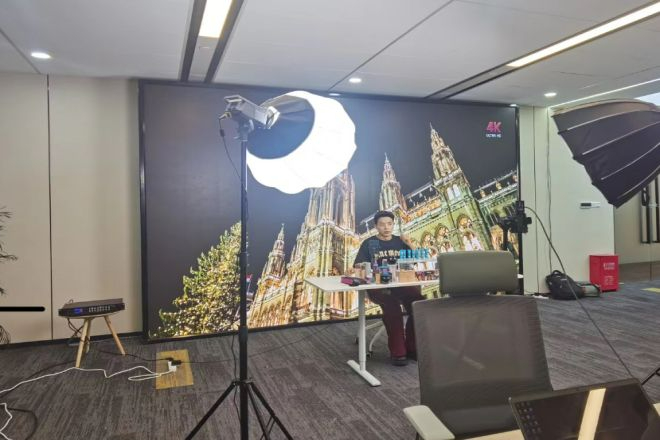Introduction
With the vigorous development of the live broadcast industry, Écrans d'affichage LED are increasingly used in live broadcast rooms. Choosing a suitable LED display screen is crucial to creating a live broadcast room atmosphere and improving viewing effects.
However, in the purchase process, many users are often prone to misunderstandings. This article will deeply analyze the five major misunderstandings in the purchase of live broadcast room LED screens to help you make a wiser choice.
Misunderstanding 1: Only look at the price and ignore the quality
When buying LED display screens, many people stare at the price, thinking that cheap is profitable, but often ignore the quality of the product.
1). Analysis of misunderstandings:
- Price is not the only criterion:
Low price is not necessarily a good thing, sometimes low price means that the quality is also discounted. The material is not good, the workmanship is rough, there are many problems with its use, and the lifespan is short.
- Live broadcasts cannot go wrong:
If there is a problem with the LED screen during live broadcasts, it will be terrible. If the picture is not clear, the screen flickers or even the screen is directly black, the audience will definitely run away, and it may also affect your reputation.
2). Correct approach:
- Look at it comprehensively:
When choosing an LED screen, don’t just look at the price, but also consider the quality and service. Check out the résolution, luminosité, and how long it will last and whether it is stable.
- The price-performance ratio is king:
The price-performance ratio does not mean that the lower the price, the better, but it depends on whether the quality, performance and price match. Don’t buy a big trouble just to save a little money.
Misunderstanding 2: Blindly pursue high-tech parameters and ignore actual needs

Some people buy LED screens and stare at those high-tech parameters, thinking that the higher the parameters, the better, but they find that they can’t use them at all after buying them.
1). Analysis of misunderstandings:
- Parameters are not omnipotent:
High parameters are indeed good, but it also depends on where you use them. The indoor live broadcast room is dark, and the screen is too bright, which is dazzling and uncomfortable to watch.
- Don’t spend money in vain:
High parameters mean high prices. If you can’t use those functions, the money will be wasted.
2). Correct approach:
- Choose on demand:
When buying an LED screen, think about what your live broadcast room needs first. For indoor use, moderate brightness, good contrast, and stable fréquence de rafraîchissement are enough.
- Don’t follow the trend blindly:
Don’t buy high-parameter products just because you see others buy them. Choose according to your budget and actual needs, and don’t waste money.
In general, when choosing an LED display, don’t just look at the price or only pursue high technical parameters. Consider the quality, service, actual needs, and budget comprehensively, and choose a cost-effective one so that you can use it confidently.
Misunderstanding 3: Generalizing without distinguishing application scenarios
When purchasing LED display screens, many users do not consider the actual application scenarios but directly choose a product that seems to have good cost-effectiveness or comprehensive functions.
However, this generalization often leads to the purchase of LED display screens that are not suitable for specific usage environments, affecting the use effect.
1). Misunderstanding analysis:
- Scenario differences:
There are significant differences in the requirements for LED display screens in different live broadcast scenarios.
For example, the indoor live studio usually has a relatively stable environment, and does not require waterproofing and dustproofing, but pays more attention to the clarity and color reproduction of the screen.
While the outdoor live studio needs to consider the influence of natural factors such as wind, rain, and sunlight, and has high requirements for waterproofing, dustproofing, brightness, and wind pressure resistance.
- The consequence of generalization:
If the indoor live studio chooses an outdoor LED display, it may cause eye fatigue to the viewer due to excessive brightness or affect the use effect due to problems such as excessive volume and inconvenient installation.
On the contrary, if the outdoor live studio chooses an indoor LED display, the screen may not work properly in an outdoor environment due to insufficient waterproofing performance and insufficient brightness.
2). Correct approach:
- Clarify the application scenario:
Before purchasing an LED display, you must first clarify whether your live broadcast scene is indoor or outdoor, and whether there are special environmental requirements (such as waterproofing, dustproofing, high temperature, etc.).
- Choisissez le bon produit :
Choose an LED display with corresponding characteristics according to the specific needs of the application scenario.
For example, an indoor live studio can choose an indoor LED display with moderate brightness and high colour reproduction; an outdoor live studio should choose an outdoor LED display with characteristics such as waterproofing, dustproofing, and high brightness.
- Tenez compte des avantages à long terme :
When choosing an LED display, you should not only consider current needs, but also future scalability and upgradeability. Choosing a product that can adapt to a variety of scenarios, easy to maintain and upgrade, can provide more convenience and possibilities for future live broadcast activities.
Misunderstanding 4: Ignoring brand and reputation, blindly following the trend

When purchasing LED display screens, some users do not pay attention to brand and reputation but blindly follow the trend to choose popular products or low-priced products.
However, this approach often makes it easy to step into the “minefield” and buy products with poor quality or inadequate service.
1). Analysis of misunderstandings:
- The importance of brand and reputation:
Brand and reputation are important guarantees of product quality and service. Well-known brands usually have more mature technology, stricter quality control systems and more complete after-sales service systems, which can provide users with more reliable products and better services.
- The consequences of blindly following the trend:
Blindly following the trend to choose popular products or low-priced products may cause various problems during use due to poor product quality (such as screen flickering, colour distortion, frequent failures, etc.), affecting the live broadcast effect and user experience.
At the same time, if the after-sales service of the selected brand is not in place, once a problem occurs, it may not be solved in time, causing unnecessary losses and troubles to users.
2). Correct approach:
- Pay attention to brand and reputation:
When purchasing LED display screens, pay attention to brand awareness and user reputation. You can learn about the product quality, service level and user satisfaction of different brands through online searches, industry reports, user reviews and other channels.
- Choose well-known brands and products with good reputation:
On the basis of understanding the brand and reputation, choose well-known brands and products with good reputation. These products are usually tested by the market and recognized by users, and they have higher reliability and cost performance.
- Consider long-term cooperation:
If you choose a satisfactory product and brand, you can consider establishing a long-term cooperative relationship with the brand. In this way, you can not only get more favourable prices and better services but also get more support and help in future live broadcast activities.
In summary, when purchasing LED display screens, you should fully consider the application scenarios and needs and choose suitable products.
At the same time, you should pay attention to brand and reputation and choose well-known brands and products with good reputations. This can ensure that the LED display screen purchased can meet the needs of live broadcasts and bring a better viewing experience to the audience.
Myth 5: Not understanding the moiré phenomenon and ignoring its impact
When purchasing LED display screens, many users know nothing about the moiré phenomenon and, therefore, ignore the negative impact it may have on the viewing effect.
Moiré is an interference pattern generated by the interaction between screen pixels and the camera or human visual system under certain conditions.
1). Analysis of misunderstandings:
- The physical properties of moiré:
Moiré is a physical phenomenon that cannot be completely eliminated, but its appearance can be reduced through some technical means.
This phenomenon is particularly obvious when the LED display screen is used with a camera or camcorder, especially when the shooting distance, angle or screen resolution does not match the camera sensor.
- The consequences of ignoring moiré:
If the moiré phenomenon is ignored, the viewing effect of the live broadcast room may be seriously affected. The appearance of moiré will destroy the clarity and coherence of the picture, make the audience feel uncomfortable, and may even affect the professionalism and credibility of the live broadcast.
2). Correct approach:
- Understand the moiré phenomenon:
Before purchasing an LED display screen, you should fully understand the moiré phenomenon and the causes of its occurrence. This will help users take effective measures to reduce the appearance of moiré in the subsequent selection and use process.
- Choose a high refresh rate display:
A high refresh rate LED display can more effectively reduce the generation of moiré because a high refresh rate means that the screen updates faster and can present dynamic images more accurately, thereby reducing interference with the camera or human visual system.
- Adjust the shooting distance and angle:
When using an LED display for live broadcasting, you can reduce the appearance of moiré by adjusting the camera’s shooting distance and angle. Appropriate shooting distance and angle can ensure pixel matching between the camera and the screen, thereby reducing the generation of interference patterns.
6. How to correctly choose a live broadcast room LED screen

1). Clear needs:
Before choosing an LED display, you should clarify your needs, including application scenarios (indoor or outdoor), budget, technical requirements (such as resolution, brightness, refresh rate, etc.) and expected viewing effects.
Make a reasonable purchase plan based on the actual needs and budget of the live broadcast room.
2). Understand the product:
When choosing an LED display, you should have a detailed understanding of the product’s technical parameters, quality, service, and other aspects.
You can obtain detailed information about different brands and products through online searches, industry reports, user reviews, and other channels.
3). Field investigation:
When choosing an LED display, you should conduct a field investigation on the manufacturer’s production capacity and product quality.
By visiting the manufacturer’s production line, testing laboratory, and viewing actual product samples, you can evaluate the manufacturer’s strength and product quality.
4). Choose a well-known brand:
Choosing a well-known brand and a product with a good reputation can get better quality and service guarantees.
Well-known brands usually have more mature technology, stricter quality control systems, and more complete after-sales service systems, which can provide users with more reliable products and better services.
Conclusion
Choosing a suitable LED display is crucial to improving the viewing effect of the live broadcast room. In the purchase process, users should avoid falling into misunderstandings. Clarifying needs, understanding products, field investigations, and choosing well-known brands are the keys to correct purchases.
I hope this article can help users better understand the misunderstandings and correct practices of purchasing LED screens for live broadcast rooms, and choose the most suitable products for themselves.
Enfin, si vous souhaitez en savoir plus sur les écrans LED, veuillez nous contacter.
